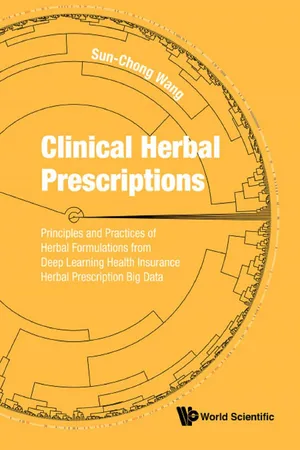
Clinical Herbal Prescriptions
Principles and Practices of Herbal Formulations from Deep Learning Health Insurance Herbal Prescription Big Data
- 520 pages
- English
- ePUB (mobile friendly)
- Available on iOS & Android
Clinical Herbal Prescriptions
Principles and Practices of Herbal Formulations from Deep Learning Health Insurance Herbal Prescription Big Data
About this book
Since AlphaGo defeated Ke Jie (who was then ranked 1st among all human players worldwide) May 2017, the art of Go (otherwise known as Weiqi) has entered a new era. Similarly, if we apply artificial intelligence (AI) to herbal medicine, the art of herbal prescription can experience a game change too. The author of this book has done exactly that, and via reverse engineering of the trained AI, the book details how one can compose herbal prescriptions from scratch.
As artificial intelligence (AI) technologies outperform humans in such tasks as image/voice recognition and language translation, mastering of concentrated herbal extract granules (CHEG) prescription composition by AI is not a fiction, provided large quantities of high-quality CHEG prescription data are available. Thanks to the 340 million records of modern Western medicine diagnoses and corresponding CHEG prescriptions in the National Health Insurance Reimbursement Database (Taiwan) recorded in the decade between 2004 and 2013, the book is based on the results of applying state-of-the-art deep learning technologies to the CHEG prescription big data.
Contents:
- Basics:
- Introduction
- Therapeutic Classes of CHEG Formulas
- Therapeutic Classes of CHEG Herbs
- Personalization:
- Sex
- Ageing
- Weather
- CHEG Combinatorials:
- Strategies of CHEG Herbology
- Anatomy of a CHEG Prescription
- AI Prescriptions:
- Non-Psychotic Mental Disorders
- Upper Respiratory Disorders and Infectious Diseases
- Skin Diseases
- Digestive System Diseases
- Endocrine and Metabolic Disorders
- Neoplasms
- Reproductive System Disorders
- Circulatory and Blood Diseases
- Symptoms and Musculoskeletal System Disorders
- Nervous, Sensory, Congenital, and Pregnancy Related Conditions
- Second Hundred Commonest Health Problems
Readership: The book is for advanced students, academia and researchers in the fields of Chinese medicine and artificial intelligence. It will also be of interest to professionals, including data scientists and computer scientists as well as physicians/practitioners/clinicians, pharmacists and nurses in alternative medicine. The book is also beneficial for a general audience who is interested in evidence-based holistic self-care.Herbology;Herbalism;Deep Learning;Artificial Intelligence;Big Data;Subhealth0 Key Features:
- Indications of an herbal prescription are in standard terms in modern Western medicine
- Classifications of formulas and herbs into not only diseases but also sexes, ages of the patient, and seasons of the prescription
- Annotations of CHEG mechanisms by their uses
- Dissection of the roles of CHEG formulas and herbs in an herbal prescription
- List of recipes for the 200 most common health problems, together with doses (in grams) of the component formulas and herbs in the prescriptions, as well as their daily serving schedules
- Contents of the book are credited to the collective wisdom of the ~5,000 herbal medical doctors in Taiwan, not from the experience of a single expert as in most other books. At the end of the book, the reader will be able to compose a practical and professional herbal recipe for subhealthy conditions, out of the hundreds of CHEG formulas and herbs available in the market
Frequently asked questions
- Essential is ideal for learners and professionals who enjoy exploring a wide range of subjects. Access the Essential Library with 800,000+ trusted titles and best-sellers across business, personal growth, and the humanities. Includes unlimited reading time and Standard Read Aloud voice.
- Complete: Perfect for advanced learners and researchers needing full, unrestricted access. Unlock 1.4M+ books across hundreds of subjects, including academic and specialized titles. The Complete Plan also includes advanced features like Premium Read Aloud and Research Assistant.
Please note we cannot support devices running on iOS 13 and Android 7 or earlier. Learn more about using the app.
Information
Part I
Basics
Chapter 1
Introduction
1.1Concentrated Herbal Extract Granules (CHEG)
Table of contents
- Cover
- Halftitle
- Other Related Titles from World Scientific
- Title
- Copyright
- Dedication
- Preface
- Contents
- Part I. Basics
- Part II. Personalization
- Part III. CHEG Combinatorials
- Part IV. AI Prescriptions
- Bibliography
- Index